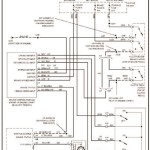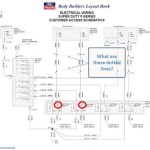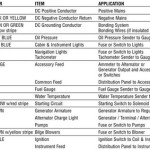Furnace Blower Motor Wiring connects power to the blower motor inside a furnace, providing the energy necessary to circulate warm air throughout a building. This wiring plays a vital role in maintaining comfortable indoor temperatures during cold weather.
Proper furnace blower motor wiring ensures the blower motor receives the correct voltage and amperage to operate efficiently and effectively. This wiring typically involves connecting the motor to a power source, such as a circuit breaker or fuse, and a thermostat, which controls the on/off operation of the blower.
The wiring of furnace blower motors has undergone significant advancements throughout history. Modern wiring techniques and materials ensure safer and more reliable operation, contributing to improved indoor air quality and comfort.
In the following article, we will delve into the details of furnace blower motor wiring, exploring its technical aspects, installation considerations, and troubleshooting techniques. By understanding the intricacies of this wiring system, homeowners and HVAC professionals can ensure the efficient and safe performance of their furnace systems.
Furnace blower motor wiring plays a critical role in maintaining efficient and effective operation of a furnace system. By understanding and addressing the key aspects of this wiring, homeowners and HVAC professionals can ensure optimal performance, safety, and longevity of their heating systems.
- Electrical Safety: Proper wiring ensures adherence to electrical codes and standards, preventing electrical hazards and potential fires.
- Motor Performance: Adequate wiring gauge and connections provide the necessary power to the motor, ensuring proper air circulation and heat distribution.
- Energy Efficiency: Optimized wiring minimizes energy losses and improves the overall efficiency of the furnace system.
- Control Integration: Wiring connects the blower motor to the furnace’s control system, allowing for precise temperature regulation and system automation.
- Reliability and Durability: High-quality wiring materials and secure connections enhance the system’s reliability, reducing the risk of breakdowns.
- Maintenance and Troubleshooting: Accessible and well-organized wiring facilitates maintenance tasks and simplifies troubleshooting efforts.
- System Lifespan: Proper wiring contributes to the longevity of the furnace system by preventing premature motor failure and other wiring-related issues.
- Professional Installation: Furnace blower motor wiring should be performed by qualified HVAC technicians to ensure adherence to best practices and safety standards.
These key aspects highlight the significance of furnace blower motor wiring, emphasizing the need for proper installation, maintenance, and troubleshooting. By considering these factors, homeowners and HVAC professionals can ensure the safe, efficient, and reliable operation of their furnace systems.
Electrical Safety
In the context of furnace blower motor wiring, electrical safety takes paramount importance. Adherence to electrical codes and standards, such as the National Electrical Code (NEC), is crucial for preventing electrical hazards and potential fires. Improper wiring can lead to loose connections, overheating, and electrical arcing, posing significant safety risks to occupants and the property.
Furnace blower motor wiring involves connecting the motor to a power source, typically through a circuit breaker or fuse, and to the furnace’s control system. Proper wiring ensures that the motor receives the correct voltage and amperage, preventing overloading and potential motor burnout. Additionally, proper grounding practices protect against electrical shock and ensure the safe operation of the furnace.
Real-life examples of electrical safety in furnace blower motor wiring include:
- Using wiring with an appropriate gauge to handle the current draw of the motor, preventing overheating and potential fire hazards.
- Securing all electrical connections with approved connectors and ensuring proper insulation to prevent arcing and electrical shock.
- Grounding the motor and other electrical components to provide a safe path for electrical current in the event of a fault or short circuit.
Understanding the importance of electrical safety in furnace blower motor wiring empowers homeowners and HVAC professionals to make informed decisions regarding the installation and maintenance of their furnace systems. By adhering to electrical codes and employing safe wiring practices, the risk of electrical hazards, fires, and personal injury can be significantly reduced, ensuring a safe and comfortable indoor environment.
Motor Performance
In the context of furnace blower motor wiring, motor performance is directly tied to the adequacy of the wiring gauge and connections. Proper wiring ensures that the motor receives the necessary power to operate efficiently and effectively, which in turn ensures proper air circulation and heat distribution throughout the building.
The wiring gauge, which refers to the thickness of the wire, determines the amount of current that can safely flow through the wire. Using an appropriately sized wiring gauge for the motor’s current draw prevents overheating, voltage drop, and potential motor damage. Proper connections, achieved through the use of approved connectors and secure terminations, minimize resistance and ensure a reliable flow of electricity to the motor.
Real-life examples of the connection between motor performance and furnace blower motor wiring include:
- A furnace blower motor wired with an undersized gauge wire may experience overheating and premature failure due to excessive current draw.
- Loose or poorly terminated connections can lead to increased resistance, voltage drop, and reduced motor performance.
- Properly sized wiring and secure connections ensure that the motor receives the necessary power to circulate air effectively, resulting in optimal heat distribution and indoor comfort.
Understanding the relationship between motor performance and furnace blower motor wiring is crucial for ensuring the efficient and effective operation of the furnace system. Proper wiring practices, including the use of appropriate wiring gauge and secure connections, contribute to the longevity of the motor, optimal air circulation, and consistent heat distribution, ultimately leading to a comfortable indoor environment.
Energy Efficiency
In the context of furnace blower motor wiring, energy efficiency is directly tied to the optimization of wiring practices. Proper wiring minimizes energy losses and improves the overall efficiency of the furnace system, reducing energy consumption and lowering utility costs.
Energy losses in furnace blower motor wiring can occur due to several factors, including:
- Undersized wiring: Using a wiring gauge that is too small for the motor’s current draw can lead to excessive resistance, voltage drop, and energy loss.
- Loose connections: Poorly terminated connections can increase resistance and result in energy dissipation as heat.
- Long wire runs: Longer wire runs can increase resistance and energy losses, especially if the wiring gauge is not appropriately sized.
By addressing these factors and optimizing wiring practices, energy efficiency can be significantly improved. Using the appropriate wiring gauge, ensuring secure connections, and minimizing wire run lengths all contribute to reducing energy losses and improving the overall efficiency of the furnace system.
Real-life examples of energy efficiency in furnace blower motor wiring include:
- Upgrading the wiring to a larger gauge can reduce resistance and energy losses, resulting in lower energy consumption.
- Tightening loose connections can improve conductivity and minimize energy dissipation as heat.
- Using shorter wire runs or employing techniques like voltage drop calculations can help reduce energy losses over long distances.
Understanding the connection between energy efficiency and furnace blower motor wiring empowers homeowners and HVAC professionals to make informed decisions regarding the installation and maintenance of their furnace systems. By employing energy-efficient wiring practices, significant energy savings can be achieved, contributing to lower utility bills and a more sustainable indoor environment.
Control Integration
Within the context of “Furnace Blower Motor Wiring,” control integration plays a crucial role in ensuring efficient and effective operation of the furnace system. Through electrical wiring, the blower motor is connected to the furnace’s control system, enabling precise temperature regulation and automated operation.
- Thermostat Integration: The thermostat acts as the central control unit for the furnace system. Wiring connects the thermostat to the blower motor, allowing the thermostat to signal the blower motor to turn on or off based on the desired temperature settings.
- Temperature Sensors: Temperature sensors are often used in conjunction with the thermostat to provide real-time temperature feedback to the control system. Wiring connects these sensors to the blower motor, enabling the system to adjust the blower speed or operation based on temperature readings from different parts of the building.
- Sequencing and Timing: In multi-stage furnace systems, wiring plays a critical role in sequencing and timing the operation of multiple blower motors or fan speeds. This ensures optimal airflow and temperature control throughout the heating cycle.
- Remote Control and Automation: Advanced furnace systems may incorporate remote control and automation features. Wiring facilitates the connection between these remote controls or automation systems and the blower motor, allowing for convenient and efficient control of the furnace system.
Overall, the control integration aspect of furnace blower motor wiring enables precise temperature regulation, automated operation, and efficient energy management. Proper wiring ensures that the blower motor responds accurately to control signals, resulting in optimal indoor comfort and reduced energy consumption.
Reliability and Durability
In the context of “Furnace Blower Motor Wiring,” reliability and durability are critical aspects that contribute to the overall performance and longevity of the furnace system. High-quality wiring materials and secure connections play a pivotal role in enhancing the system’s reliability and minimizing the risk of breakdowns.
- Quality Wiring Materials: Utilizing high-quality wiring materials, such as copper wires with appropriate insulation and temperature ratings, ensures that the electrical current flows efficiently and safely. This reduces the risk of wire damage, overheating, and potential electrical hazards.
- Secure Connections: Proper installation techniques and the use of approved connectors ensure secure and reliable connections throughout the wiring system. Loose or poorly terminated connections can lead to arcing, overheating, and increased resistance, compromising the system’s performance and lifespan.
- Corrosion Resistance: In humid or corrosive environments, using wiring materials with corrosion-resistant properties is crucial. Corrosion can degrade the electrical conductivity of wires and lead to premature failure.
- Mechanical Protection: Proper routing and protection of wiring, such as using conduit or wire trays, safeguards the wiring system from physical damage caused by vibration, movement, or external factors.
By adhering to these reliability and durability principles in “Furnace Blower Motor Wiring,” homeowners and HVAC professionals can extend the lifespan of the furnace system, minimize the likelihood of breakdowns, and ensure efficient and safe operation throughout its service life.
Maintenance and Troubleshooting
Within the realm of “Furnace Blower Motor Wiring,” maintenance and troubleshooting are crucial aspects that determine the longevity and efficiency of the furnace system. Accessible and well-organized wiring plays a pivotal role in facilitating maintenance tasks and simplifying troubleshooting efforts, ensuring that the furnace operates reliably and efficiently throughout its lifespan.
- Wiring Accessibility: Accessible wiring allows for easy inspection, maintenance, and repairs. Proper wire routing and labeling enable technicians to quickly identify and access specific wires, reducing downtime and facilitating routine maintenance.
- Organized Wiring: Well-organized wiring, using techniques such as color coding and wire bundling, enhances clarity and reduces the likelihood of misconnections. This organization simplifies troubleshooting efforts by allowing technicians to trace wires easily, identify potential faults, and resolve issues more efficiently.
- Labeling and Documentation: Clear labeling of wires and components, along with proper documentation of wiring diagrams, provides valuable information for maintenance and troubleshooting purposes. This documentation helps technicians understand the system’s configuration, identify wire connections, and resolve issues quickly.
- Test Points and Diagnostic Ports: Incorporating test points or diagnostic ports into the wiring system allows for convenient and accurate testing of electrical signals. Technicians can use these points to measure voltage, current, or other parameters, aiding in the diagnosis and resolution of electrical issues.
By prioritizing maintenance and troubleshooting through accessible and well-organized wiring, homeowners and HVAC professionals can ensure that their furnace systems operate reliably and efficiently. This proactive approach not only minimizes the risk of breakdowns but also reduces maintenance costs and extends the lifespan of the furnace system.
System Lifespan
Within the context of “Furnace Blower Motor Wiring,” the lifespan and durability of the furnace system are closely intertwined with the quality and reliability of the wiring. Proper wiring practices directly impact the longevity of the system by preventing premature motor failure and other wiring-related issues that can compromise its performance and lifespan.
Premature motor failure can occur due to various wiring-related factors, including:
- Undersized Wiring: Using wiring with an insufficient gauge for the motor’s current draw can lead to overheating, insulation breakdown, and eventual motor failure.
- Loose Connections: Poorly terminated or loose connections create high resistance points, causing arcing and heat buildup, which can damage the motor or wiring.
- Voltage Fluctuations: Improper wiring can result in voltage fluctuations that exceed the motor’s operating range, leading to premature failure.
- Corrosion: Exposure to moisture or corrosive substances can degrade the wiring’s insulation and cause shorts or open circuits, compromising the motor’s operation.
By addressing these issues through proper wiring practices, the lifespan of the furnace system can be significantly extended. Proper wire sizing, secure connections, stable voltage supply, and corrosion protection ensure that the blower motor operates within its optimal parameters, reducing the risk of premature failure and costly repairs.
Real-life examples of the impact of proper wiring on system lifespan include:
- Upgrading the wiring gauge to match the motor’s current requirements can prevent overheating and extend the motor’s lifespan.
- Regular inspection and tightening of electrical connections can eliminate potential arcing points and reduce the risk of motor damage.
- Using surge protectors or voltage regulators can safeguard the motor from voltage spikes and fluctuations, enhancing its reliability.
Understanding the connection between “System Lifespan: Proper wiring contributes to the longevity of the furnace system by preventing premature motor failure and other wiring-related issues.” and “Furnace Blower Motor Wiring” empowers homeowners and HVAC professionals to make informed decisions regarding the installation and maintenance of their furnace systems. By prioritizing proper wiring practices, they can ensure the longevity, reliability, and efficient operation of their furnace systems for many years to come.
Professional Installation
Within the context of “Furnace Blower Motor Wiring,” professional installation plays a critical role in ensuring the safety, efficiency, and longevity of the furnace system. Qualified HVAC technicians possess the knowledge, skills, and experience necessary to perform blower motor wiring in accordance with established best practices and safety standards.
- Electrical Code Compliance: HVAC technicians are well-versed in the National Electrical Code (NEC) and local building codes, ensuring that blower motor wiring complies with all applicable safety regulations. This compliance minimizes the risk of electrical hazards, such as fires and electrical shock.
- Proper Wire Sizing and Connections: Using the appropriate wire gauge and making secure electrical connections are crucial for efficient and safe operation of the blower motor. Improper wire sizing can lead to overheating and potential motor damage, while loose connections can create arcing and increase the risk of electrical fires.
- Grounding and Bonding: Proper grounding and bonding techniques protect against electrical shock and ensure the safe operation of the furnace system. HVAC technicians have the expertise to implement these measures effectively.
- System Compatibility: Matching the blower motor wiring to the specific furnace system is essential for optimal performance and energy efficiency. Trained HVAC technicians understand the compatibility requirements and can ensure that the wiring is tailored to the system’s specifications.
By entrusting furnace blower motor wiring to qualified HVAC technicians, homeowners and building managers can benefit from peace of mind knowing that their furnace system is installed and maintained according to the highest standards of safety and efficiency. Professional installation not only ensures immediate reliability but also contributes to the long-term lifespan of the furnace system, reducing the likelihood of costly repairs and premature replacement.










Related Posts








